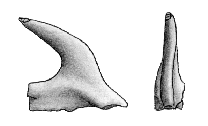| |

 Below is a minute tooth which belongs to the basking shark. The extant species, Cetorhinus maximus
(GUNNERUS, 1765) is the second largest shark in the modern
ocean. Only Rhincodon, the whale shark, another filter-feeder and
the extinct Carcharocles grew larger. This coastal-pelagic species has unique
gill-rakers which are shed seasonally and used for filtering plankton. The dentition
is made up of a couple hundred files of teeth which are hook-shaped with stout, poorly
defined bilobate roots.
Below is a minute tooth which belongs to the basking shark. The extant species, Cetorhinus maximus
(GUNNERUS, 1765) is the second largest shark in the modern
ocean. Only Rhincodon, the whale shark, another filter-feeder and
the extinct Carcharocles grew larger. This coastal-pelagic species has unique
gill-rakers which are shed seasonally and used for filtering plankton. The dentition
is made up of a couple hundred files of teeth which are hook-shaped with stout, poorly
defined bilobate roots.
Fossil basking shark teeth from the Miocene have been ascribed to the species
C. parvus (LERICHE 1908). Additional research is required
before the Lee Creek specimens can be assigned to a particular species.
Teeth and gill-rakers of this animal are rare, and primarily found by fine screening
tailings from the waste piles. Recovered teeth, gill-rakers and a single clasper
have all come from sediments attributable to the Pungo River formation.
Special thanks to John Fitez for loan of the tooth specimen.
 |
 |
Fig. 1 - Cetorhinus sp, gill-raker
height 2.2 mm
Pungo River specimen |
Fig. 2 - Cetorhinus sp
lateral view, hgt 3 mm
Pungo River specimen
Image by Bill Heim © 1998 |
|